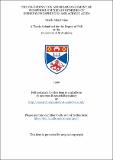The co-ordination and rearrangement of phosphorous mixed antihydrides of diphenylphosphinous and acrylic acids
Abstract
The reactions of acrylic and vinylacetic acids with Ph₂PCl and Et₃N give Ph₂PO₂CCH=CH₂ (AAA) and Ph₂PO₂CCH₂CH=CH₂ (VAA) respectively. Both are found to undergo a facile rearrangment to give Ph₂PP(O)Ph₂ and AAA is also found to react with PPh₃ to give Ph₃P+-CH₂CH₂CO₂-. Their reaction (1 mole ligand to 1 mole Rh) with [(RhCl(1,₅ COD))₂], gives complexes of the form [(RhCl(L)₂], where L is AAA or VAA, in which the mixed anhydride ligands are bound via the phosphorus atom and the double bond. With AAA in a 1:2 mole reaction with [(RhCl(1,5 COD))₂] or a 1:1 mole reaction with [(RhCl(C₂H₄)₂)₂l, the major products are [(RhCl(AAA))₂ (Ph₂POPPh₂)] and [RhCl(AAA)₂], in which the mixed anhydride is bound as described above and the Ph₂POPPh₂ is a bridging ligand. Reaction (1:1) of AAA with [RhCl(PPh₃)₃] led to the formation of [RhCl(AAA)(PPh₃)]; anhydride coordination is as above and the phosphorus atoms are mutually trans. This complex is, however, found to revert back to [RhCl(PPh₃)₃] on standing. The (1:1) reaction with VAA produces [RhC1(PPh₃) (Ph₂PO₂CCH = CHMe)] (Ph₂PO₂CCH=CHMe = CAA), an example of a metal promoted double bond migration. Subsequent study shows that at ambient pressure and temperature this complex (with 3 butenoic, oleic and hexa-4-enoic acids) is involved in stoichiometric and not catalytic reactions. [RhCl(CAA)(PPh₃)] exhibits fluxionality at room temperature, 31p and 1H n.m.r, studies on this complex (₂₂₃-₂₆₃K) and on [Rh(CAA)(O₂CCH=CHMe)(PPh₃)] (₂₉₈K) has determined the fluxionality to be a fast exchange between the cis and trans forms and led to the calculation of the thermodynamic parameters for this process . The 1:₂ mole reaction of [RhCl(PPh₃)₃] and AAA gives lRhCl(PPh₃)(Ph₂POPPh₂)], which contains a chelate tetraphenyl diphosphoxane ligand (tpdp) formed via a metal promoted rearrangement of the AAA ligand. Subsequent reaction of this complex with TIPF₆ results in [Rh(PPh₃)₂(tpdp)][PF₆]. However if the [RhCl(PPh₃)(tpdp)] complex is not isolated, then the major product is [Rh(PPh₃)₃(Ph₃PCH₂CH₂CO₂)][PF₆]. Further tpdp complexes have been formed by refluxing Ph₂PP(O)Ph₂ with [RhCl(PPh₃)₃], [RuCl₂(PPh₃)₄] and [OsCl₂(PPh₃)₄] in THF. However the reaction of [RhCl(PPh₃)₃] with excess Ph₂PP(O)Ph₂ gives several products, one of which, namely [RhCl₂((PPh₂O)₂)H(PPh₂O)][HNEt₃], has been crystallographically characterised. The reaction (1:1) of [RuCl₂(PPh₃)₄] with Ph₂PO₂CCHCMe₂ (DAA) produces [RuCl₂(PPh₃)₂(DAA)], in which the mixed anhydride is bound via the phosphorus atom and the oxygen atom of the carbonyl group. The 1:1 mole reactions of CAA and AAA give similar complexes as minor products whilst the structure of the major product is, however, not known at this point in time. The 1:2 mole reaction was found to produce [RuCl₂(tpdp)(AAA)(PPh₃)] in which the mixed anhydride is bound via the phosphorus atom alone.
Type
Thesis, PhD Doctor of Philosophy
Collections
Items in the St Andrews Research Repository are protected by copyright, with all rights reserved, unless otherwise indicated.

